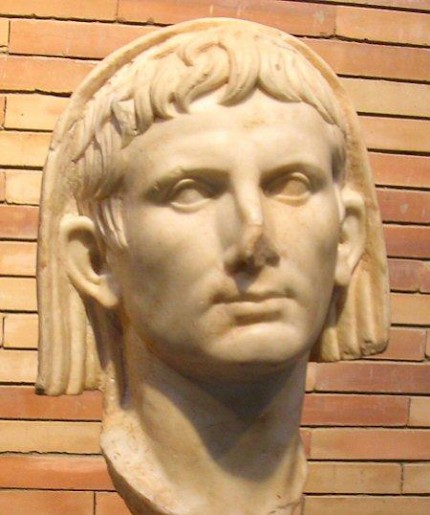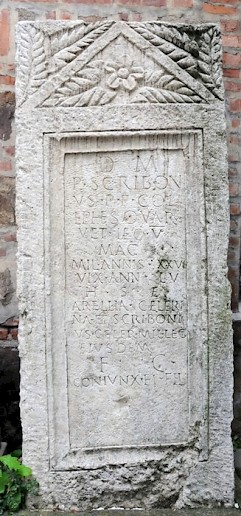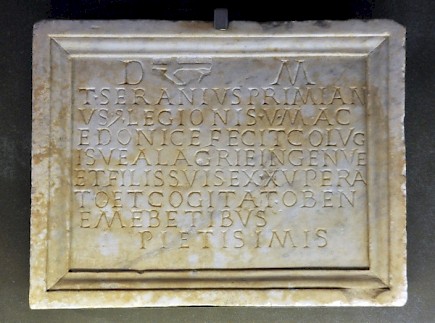Legio V Macedonica
Legio V Macedonica: one of the Roman legions. Its name means "the legion from Macedonia".

This legion was probably recruited by consul Gaius Vibius Pansa and Octavian (the later emperor Augustus) in 43 BCE. There are no records of the first decades of its existence, although we know of the existence of two fifth legions, V Urbana and V Gallica, that may be identical to our unit. It was very probably present at Actium (31), after which veterans were settled in the Veneto. A later generation of veterans was sent to Phoenicia (in 15 or 14 BCE), to settle in the refounded city of Berytus, modern Beyrut. They were to share this town with former soldiers of VIII Augusta. (It is possible that this foundation was 15 years older.)
Between 30 BCE and 6 CE, the fifth legion served in Macedonia, where it received its surname.
It is possible that the legion was briefly called V Scythica, which suggests that our unit fought against the Scythians, the nomadic tribes who lived in the neighborhood of the Roman city Olbia but occasionally came to the south and tried to cross the Danube. It is likely that the fifth, together with the Fourth, legion once defeated these tribes, but we cannot date this victory. A possible candidate is the war waged in the years 29-27 by the Roman commander Marcus Licinius Crassus (a grandson of the triumvir), who is known to have slain an enemy leader in single combat.
The legion was perhaps involved in the campaign of Tiberius, the future emperor, against the Parthian Empire in 20 BCE. (Other legions in this campaign were III Gallica, VI Ferrata, X Fretensis and XII Fulminata). The Parthians were impressed and returned the eagle standards they had obtained after the Roman general Crassus' defeat at Carrhae in 53 BCE.
Fighting was not the only activity of the legion. Several inscriptions attest to the construction of roads and other works of engineering in the Danube area. The newly conquered country still needed to be developed. Usually, IIII Scythica joined forces with V Macedonica.
It is likely that Velleius Paterculus, who claims to have seen the delta of the Danube, served in the Fifth.note

In 6, it was transferred to Oescus (modern Gigen) in Moesia, where it was to stay until 61, guarding the Lower Danube frontier against the tribes of Dacia. At this point, the river Olt empties itself in the Danube. This river is more or less the main road into Dacia.
The Fifth was active when the emperor Claudius decided to annex Thrace in the Roman empire in 45/46 CE. Details, however, are poorly understood.
In 62, the fifth legion was transferred to the east, where it was stationed in Pontus, south of the Black Sea. Nero's general Lucius Caesennius Paetus, the governor of Cappadocia, employed XII Fulminata and IIII Scythica - which had been transferred a bit earlier - and subunits of V Macedonica during a disastrous campaign in Armenia. This army was forced into surrender, and it was left to the governor of Syria, Gnaeus Domitius Corbulo, to launch a retaliatory campaign with the legions III Gallica, VI Ferrata, and X Fretensis. This time, V Macedonica seems to have sent its main force, which was commanded by Annius Vinicianus, Corbulo's son-in-law.
V Macedonica was probably still in the east when war against the Jews broke out (66; more), and the legion was placed under the command of Titus Flavius Vespasianus - the future emperor Vespasian. Together with X Fretensis and XV Apollinaris, it was active in Galilee, where Sepphoris was liberated in 67. In the next years, the Romans slowly moved to the south. One of the more notable exploits of the Fifth was the storming of Mount Gerizim, the chief sanctuary of the Samaritans. In 68, the war was interrupted because the emperor Nero had committed suicide. The legion stayed for some time at Emmaus. The presence of several tombstones suggests some hard fighting.
During the next summer, Vespasian was proclaimed emperor, and he went to Alexandria, where he cut off the grain supply of Rome. Before the year 69 was out, he was recognized by the Senate. His son Titus continued the war in 70 and took Jerusalem (more). After the Roman victory, the fifth legion escorted Titus to Alexandria and returned to Moesia, to Oescus. It had been away from home for almost ten years.
In the mid-eighties, the emperor Domitian reorganized the frontiers of the Rhine and Danube. Moesia was divided into two provinces, called Superior and Inferior. V Macedonica belonged to Moesia Inferior, together with I Italica and XI Claudia. This reorganization had become necessary after the Dacians had invaded the Roman empire in 86 and defeated the legions that were supposed to defend Moesia. In 88, a large Roman army group invaded Dacia and general Tettius defeated its king Decebalus at Tapae; the Fifth was one of nine legions involved. Unfortunately, the revolt of the governor of Germania Superior, Lucius Antonius Saturninus, in 89, prevented the ultimate success.

One of the legion's officers in these years was the future emperor Hadrian (in 98). Later, the Fifth took part in Trajan's campaigns against the Dacians (101-106), and on its return, it was transferred to the northeast, to Troesmis (modern Iglita) near the delta of the Danube in 107. Here, it faced the Roxolani, a tribe that was sometimes restless (a.o. in 118) and needed to be guarded.
Later during the reign of Trajan, a subunit of the fifth Macedonian legion was sent to the east, to take part in his disastrous Parthian campaigns (115-117). A second eastern expedition took place when a subunit was sent to Judaea, to suppress the messianic revolt of Simon ben Kosiba (132-136), one of the worst wars Rome ever fought.
At this time, several soldiers served in the headquarters of the governor of Moesia Inferior, in Tomis. Other soldiers, and legionaries of XI Claudia, were among the builders of the fort at Draschna in the southeastern Carpates in the valley of the Buzau. One of the legion's other tasks was the occupation of the Crimea, where several Greek towns were protected by Roman units. The Moesian legions were by turn responsible for this outpost. Several inscriptions attest the presence of soldiers of V Macedonica, I Italica, and XI Claudia.
The eastern campaign of Trajan was, with more success, repeated in the 160s, when Lucius Verus waged war against Parthia. Returning from the east, the Fifth was based in Potaissa in the province of Dacia Porolissensis (modern Turda). At this stage, the northern frontier was reorganized, because several tribes, like the Marcomanni, Sarmatians and Quadi, had become restless. The emperor Marcus Aurelius spent almost ten years of his reign fighting on the Middle Danube. Early during the reign of Commodus, Pescennius Niger and Clodius Albinus (both future emperors), commanded V Macedonica and XIII Gemina, and defeated the Sarmatians again.
When this war had been brought to a good end, the Romans turned their attention to the Dacians in the interior. Workers of the gold mines had revolted and had hired a mercenary army. When they had been defeated by V Macedonica, the emperor Commodus awarded the legion the title Pia Constans ("Faithful and reliable") or Pia Fidelis ("Faithful and loyal") in 185 or 187.
In 193, the governor of Pannonia Superior, Lucius Septimius Severus marched on Rome to expel Didius Julianus, who had become emperor after the respected old Publius Helvius Pertinax had been lynched by his soldiers. The governor of Dacia Porolissensis was his brother Geta, and V Macedonica immediately sided with the new ruler, whose reign was to last until 211. A mixed subunit of V Macedonica and XIII Gemina accompanied Severus to Rome, during his war against his rival Pescennius Niger, and against the Parthians. It would be interesting to know the attitude of the soldiers towards the next civil war, which Severus fought against Clodius Albinus, a former officer of V Macedonica.
The legion was to stay at Potaissa for the greater part of the third century. Several monuments have been found that prove its stay, such as an inscription from 259. We also know that in 244-245, V Macedonica and XIII Gemina defeated the Carpi, aggressive tribesmen from the Carpates.
The emperor Valerian (253-260) gave our unit the title Pia III Fidelis III ("Thrice faithful and loyal"). This means that the legion had already received the title Pia II Fidelis II, but we do not know when. During the reign of Valerian's son Gallienus (260-268), the title Pia VII Fidelis VII is attested. It is probable that the Fifth received the honorific titles IV, V, and VI because it had supported Gallienus with a mobile cavalry unit (an innovation!) against the usurpers Ingenuus and Regalianus (both 260 in Moesia). This subunit was also employed against Victorinus (in Gaul in 269-271).
When the emperor Aurelian gave up Dacia in 274, the legion returned to Oescus, which was to be its base for the third time. However, there were other forts as well: Cebro, Sucidava, and Variniana also offered accomodation to soldiers of the Fifth Kegion.
The cavalry subunit founded by Gallienus was taken away from the legion by the emperor Diocletian (284-305). It became part of the mobile army that was the core of the Roman army of late antiquity. In 293, it was sent to Memphis in Egypt, but first had to play a part in a war against the Sasanian Persians (who had replaced the Persians as Rome's eastern enemies). Diocletian's general Galerius and his army were defeated in Mesopotamia in 296. Next year, however, he invaded Armenia, and then invaded southern Mesopotamia. When a peace treaty had been signed, the soldiers of the cavalry unit were finally sent to Egypt, where they were to stay until the early fifth century.
After 400, these soldiers are found in Syria, which is the last time we hear from them. The old mother-legion had remained in Moesia, where it is still attested at the beginning of the fifth century. Both units must have been integrated in the Byzantine army.
The symbol of this legion was a bull. The eagle was also used. (Of course, all legions had eagle standards, but V Macedonica seems to have had a special link to Jupiter's favorite bird.)
Literature
- I. Piso, "Les légions dans la province de Dacie", in: Yann Le Bohec, Les légions de Rome sous le Haut-Empire (2000 Lyon) 205-225
- K. Strobel, "Zur Geschichte der Legiones V (Macedonica) und VII (Claudia pia fidelis) in der frühen Kaiserzeit und zur Stellung der Provinz Galatia in der augusteischen Heeresgeschichte", in: Yann Le Bohec, Les légions de Rome sous le Haut-Empire (2000 Lyon) 515-528
- C. Zuckermann, "Legio V Macedonia in Egypt", in: Tyche 3 (1988) 279-287